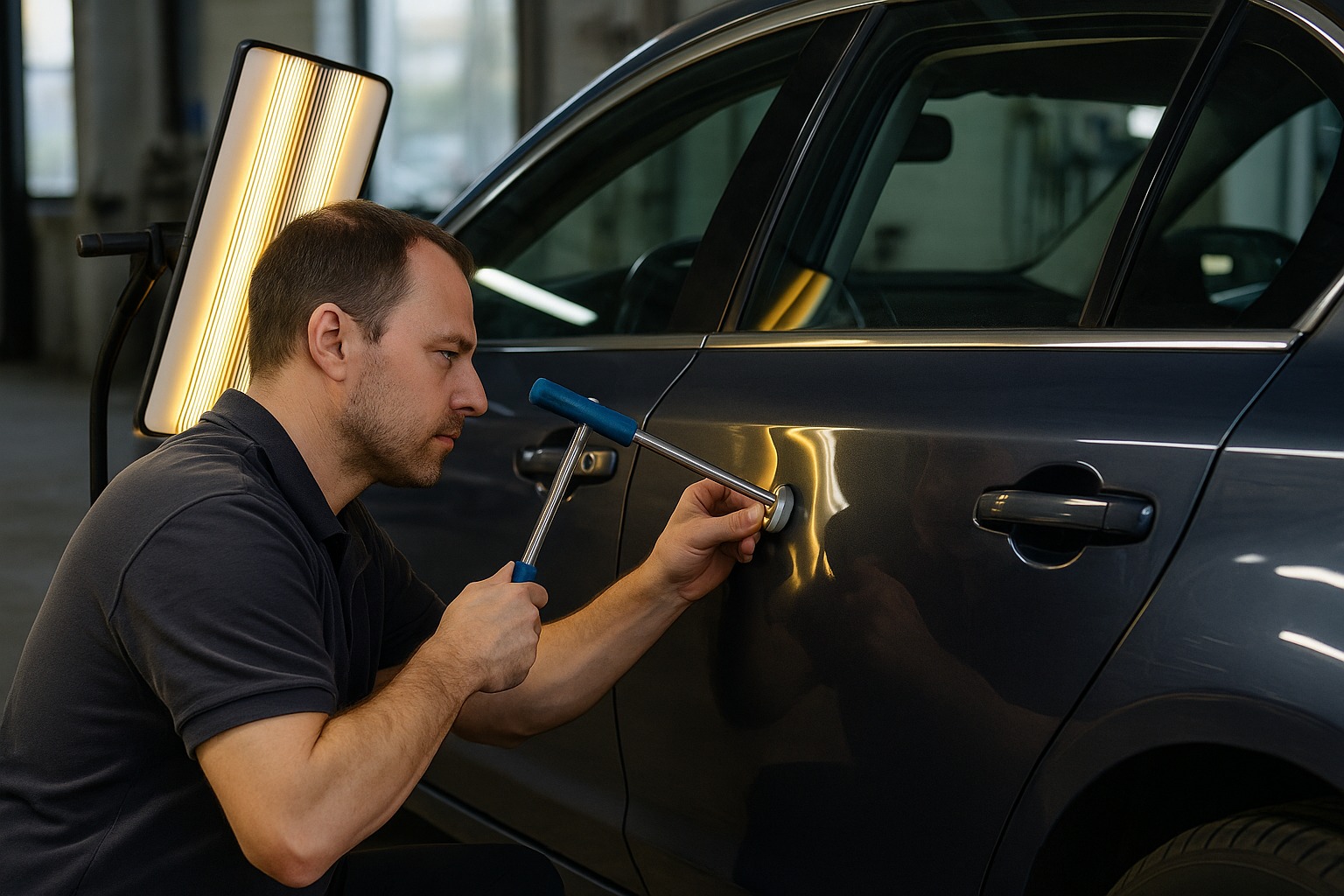When people search for “dent repair near me”, they usually want quick and reliable solutions for car dents, scratches, or dings. In the auto repair industry, this phrase covers several services such as auto dent repair, paintless dent repair (PDR), and dry denting. Each method has its own process, tools, and level of expertise required.
Dents are more than just a cosmetic problem. If left untreated, they can lower your car’s resale value, expose the metal underneath to rust, and in some cases even affect the structural strength of panels. A small dent today can easily become a more expensive repair tomorrow if ignored. That’s why professional dent repair matters—it helps preserve your vehicle’s value, safety, and appearance, while often saving you money compared to traditional bodywork.
In this guide, I’ll walk you through everything you should know about dent repair. We’ll look at the main repair methods available, the pros and cons of each, how much they usually cost, what to expect during the repair process, and insider tips from years of experience in the market. Whether you’re dealing with a minor door ding or major hail damage, this article will help you understand your options and make the right choice when searching for the best dent repair near you.
- Understanding Dent Repair: Types & Techniques
- How To Find Dent Repair Shops “Near Me”
- What To Expect: The Repair Process
- Costs & Time: What You’ll Pay In Practice
- Working With Insurance, Warranties & Value Preservation
- Expert & Insider Tips (Uncommon / Advanced Advice)
- Localised / Regional Considerations “Near Me”
- Case Studies / Real-Life Examples
- Conclusion
- FAQ’s:
- Is Dry Denting The Same As Paintless Dent Repair (PDR)?
- Can All Dents Be Repaired Without Repainting?
- Will Dent Repair Show Up On My Insurance History?
- How Long Does A PDR Repair Last? Will The Dent Return?
- What Kind Of Damage Disqualifies Me From PDR?
- How Should I Care For The Repaired Area Afterward?
- Will Dent Repair Affect My Car’s Resale Value?
- FAQ’s:
Understanding Dent Repair: Types & Techniques
What Qualifies As A Dent
In my years working on vehicles, I’ve seen dents in every shape and size. A dent is essentially any deformation of a car’s surface that disrupts its smooth finish. Here are the common types:
- Small dings – usually caused by shopping carts, door bumps, or falling objects. These are shallow and often perfect candidates for paintless dent repair.
- Large dents – deeper impressions that stretch metal, usually from a bigger impact like a fender bender.
- Creases – sharp, folded dents where the metal has been dragged. These are tougher to repair and sometimes need repainting.
- Hail damage – multiple small dents scattered across the hood, roof, and trunk after a hailstorm.
- Collision damage – significant dents from accidents, often affecting more than just the panel surface.
- Bumper dents – common on modern plastic bumpers. These can sometimes “pop out,” but not always without leaving stress marks.
Traditional Dent Repair Vs Paintless Dent Repair (PDR) Vs Dry Denting
- Traditional Dent Repair
This method involves sanding, filling the dent with body filler, and repainting the panel. It works on all materials—steel, aluminum, and plastics—but it’s more time-consuming and can affect the original factory paint finish. - Paintless Dent Repair (PDR)
PDR is a technique where special rods, levers, or glue pulling systems are used to massage the metal back into shape without disturbing the paint.- When it works best: Shallow dents, no paint damage, typically on steel and aluminum panels.
- When it doesn’t: If the paint is cracked, the dent is on an edge, or the metal is overstretched.
- Benefits: Retains factory paint, quicker, usually cheaper.
- Dry Denting
This is similar to PDR but often done with minimal tools—sometimes with suction cups or heat/cold methods. It can work on simple, shallow dents but is less precise than professional PDR.
Other Methods
- Filler & Repaint – After sanding, body filler is applied, shaped, and then the area is repainted.
- Panel Replacement – For severe dents that compromise safety or can’t be restored, the entire panel (door, fender, hood) is replaced.
- Glue Pulling – A common PDR method where tabs are glued to the dent and pulled outward before refinishing.
- Body Filler Touch-ups – Smaller areas may use minor filler for a smooth finish.
- Dry Denting Techniques – Sometimes marketed as quick fixes but generally not as reliable for long-term durability.
Advantages & Disadvantages Of Each Method
- Traditional Repair
- Can fix any dent, no matter how severe.
- Restores shape and finish completely.
- More expensive and time-consuming.
- Paint may not perfectly match factory finish.
- Paintless Dent Repair (PDR)
- Fast and affordable.
- Keeps factory paint intact (better resale value).
- Great for small to medium dents and hail damage.
- Limited use on sharp creases, cracked paint, or deep dents.
- Dry Denting / DIY Techniques
- Cheap, quick attempts.
- Works on very shallow dents in flexible panels.
- Results are inconsistent and often temporary.
- Can cause paint cracking or warping if done incorrectly.
- Filler & Repaint
- Smooth finish if done by professionals.
- Necessary for deep dents and paint damage.
- Expensive, time-intensive.
- Can reduce long-term value because factory paint is lost.
- Panel Replacement
- Best for safety and structure when damage is severe.
- The most costly option.
This is the technician’s breakdown of dent repair. Each method has its place, and knowing when to choose one over the other can save you time, money, and frustration.
How To Find Dent Repair Shops “Near Me”
When your car needs dent repair, the real challenge isn’t just knowing which method works best—it’s finding the right shop near you. From experience, I can tell you that where you take your car makes a huge difference in both quality and cost.
Local Search Strategies
The first step is to use the tools already at your fingertips:
- Google Maps & Search – Typing “auto dent repair near me” or “paintless dent repair near me” will show nearby shops, their locations, hours, and customer ratings.
- Reviews – Don’t just look at the star rating. Read the comments to see how the shop handles complaints, whether customers mention fair pricing, and if repairs lasted long-term.
- Social Media & Forums – Local car enthusiast groups on Facebook or auto forums are often full of honest recommendations. People love sharing their experiences—good or bad.
What To Look For In A Good Repair Shop
When you’re standing in front of a dent repair shop, here’s what I would personally check:
- Certifications & Training – Look for technicians certified in Paintless Dent Repair (PDR) or body repair. Proper training means they understand how to work on different metals like steel, aluminum, and even modern plastics.
- Experience & Tools – A shop that’s been around for years usually has both skilled technicians and the right equipment. PDR requires precision rods, glue pull systems, and lighting tools that not every shop invests in.
- Mobile PDR Options – Some shops offer mobile services, where a technician comes to your home or workplace. This is convenient, but always make sure they’re using professional equipment.
- Guarantees & Warranties – A trustworthy shop stands behind its work. Ask if they guarantee repairs against the dent reappearing.
- Before-and-After Photos – Many professional shops showcase their work. If they’re proud of it, they’ll be happy to show you.
- Customer Testimonials – A steady flow of happy clients says more than any advertisement.
Comparing Shops: Estimating Cost, Time, And Quality
Once you’ve found a few options, don’t settle immediately. Comparing is key:
- Get Multiple Quotes – Always ask at least two or three shops for an estimate. Prices can vary widely even for the same dent.
- Ask the Right Questions –
- How long will the repair take?
- Will PDR work for this dent, or is traditional repair required?
- Does the quote include paint, labor, and materials?
- Watch for Hidden Costs – Some shops may give a low estimate but add charges later for paint blending, extra labor, or panel removal. Get everything in writing before they start.
Finding the right dent repair shop “near me” isn’t just about convenience—it’s about trust. A skilled technician can make a dent disappear like it was never there, while an inexperienced one can leave ripples, mismatched paint, or even weaken your car’s panel.
What To Expect: The Repair Process
Most car owners are a little nervous the first time they bring their vehicle in for dent repair. I get it—you don’t know what goes on behind the shop doors, and you want to be sure your car is handled with care. Let me walk you through what actually happens, step by step, so you know exactly what to expect.
Initial Inspection And Estimate
When you arrive, the technician will first inspect the damage. Here’s what they’re looking for:
- Size & depth of the dent – small dings often mean quick PDR fixes, while deeper dents may need more work.
- Location – dents near edges or on body lines are harder to repair.
- Condition of the paint – if paint is cracked or chipped, PDR might not be possible.
- Material – steel panels respond differently than aluminum or plastic bumpers.
Based on this, they’ll give you a written estimate that covers labor, tools, paint (if needed), and how long it will take.
Paintless Dent Repair (PDR) / Dry Denting Process
If your dent qualifies for PDR, here’s how the process usually works:
- Accessing the Dent – The technician may remove panels, trim, or liners to reach the back of the dent.
- Special Tools – Using precision rods and levers, they gently massage the dented area from behind, slowly restoring it to its original shape.
- Glue Pulling – For spots where access is limited, glue tabs are placed on the dent and carefully pulled outward.
- Lighting & Reflection Boards – Special lights are used to see even the tiniest imperfections while working.
- Final Touch – The surface is smoothed until it matches the surrounding area perfectly.
The beauty of PDR is that your factory paint remains untouched, which helps preserve resale value.
Traditional Repair Steps
When PDR isn’t possible (like with cracked paint, sharp creases, or very deep dents), the repair process looks different:
- Sanding & Preparing the Area – Damaged paint is sanded away.
- Filling the Dent – A professional-grade body filler is applied, then shaped to match the panel’s contour.
- Priming & Painting – The area is primed, color-matched, and repainted.
- Blending & Finishing – The new paint is blended with surrounding panels and finished with a clear coat for protection.
This process takes longer and usually costs more, but it’s sometimes the only way to restore the panel.
Quality Checks And Final Inspection
Before handing your car back, a good shop will:
- Check paint match under natural and artificial light.
- Run a reflection test to ensure the surface is smooth with no ripples.
- Verify durability by making sure the dent doesn’t “pop back.”
- Clean & polish the area so it looks like nothing ever happened.
From start to finish, a professional repair should leave you with a car that looks as if the dent never existed. And if you’ve chosen the right shop, you’ll also get a warranty that gives peace of mind for the future.
Costs & Time: What You’ll Pay In Practice
One of the first questions customers ask me is, “How much will this cost and how long will it take?” The honest answer is: it depends. Dent repair pricing is not one-size-fits-all—it varies based on the size of the dent, its location, the method used, and even the material of the panel. Let’s break it down.
Typical Cost Ranges
From my shop-floor experience, here’s what you can usually expect:
- Small dings (quarter-sized or smaller): $50 – $150 using Paintless Dent Repair (PDR).
- Medium dents (golf ball to palm-sized): $150 – $400 depending on location and depth.
- Large dents or multiple hail dents: $400 – $1,000+. Hail damage across the hood or roof often costs more because of the sheer number of dents.
- Traditional body repair (with filler & repaint): $300 – $1,500+, especially if repainting a large panel or blending paint into surrounding areas.
- Panel replacement: $500 – $2,000+ depending on the make and model of your vehicle.
Remember—luxury cars and aluminum panels generally cost more to repair because they require special tools and additional time.
How Material Matters
- Steel panels – Standard and cheaper to repair with PDR.
- Aluminum panels – Found on many modern vehicles. Stronger but more flexible, requiring specialized tools. Expect to pay more.
- Plastic bumpers – Can sometimes be heated and reshaped, but deep dents may still require filler and repaint.
Mobile Vs Shop-Based Repair
- Mobile PDR Technicians
- Convenient—they come to your home or workplace.
- Usually cheaper for small dents.
- Limited equipment—hard to handle complex dents.
- May not have paint-matching tools if repainting is needed.
- Shop-Based Repair
- Full set of tools, lighting, and paint systems.
- Better for larger or tricky dents.
- Less convenient—you’ll need to leave your car at the shop.
- May take longer if the shop is busy.
Turnaround Time
- Small dents with PDR: Often done in 30 minutes to 2 hours.
- Multiple dents / hail damage: 1–3 days, depending on severity.
- Traditional filler & repaint jobs: 2–5 days, allowing for paint curing and finishing.
- Panel replacement: Up to a week or longer if parts need to be ordered.
Technician’s Tip: Always ask for both a time estimate and a cost estimate before leaving your car. A professional shop won’t hesitate to give you a clear breakdown.
Working With Insurance, Warranties & Value Preservation
From the customer side, dent repair isn’t just about fixing the damage—it’s also about who pays for it, whether the repair is guaranteed, and how it affects your car’s long-term value. Having handled hundreds of cases, here’s how it usually works in practice.
Insurance Claims: How Dent Repair Is Handled
Most dents fall into two categories when it comes to insurance:
- Comprehensive coverage – This usually applies to hail damage, falling objects, or vandalism. If you have comprehensive insurance, there’s a good chance the repair will be covered (minus your deductible).
- Collision coverage – This covers dents from accidents, like a fender bender or hitting a pole. Again, you’ll need to check your deductible before filing a claim.
Technician’s Advice: If the repair cost is close to your deductible, it might not be worth filing a claim. Insurance records can affect your premiums, so sometimes paying out of pocket for small dents is the smarter move.
Warranties From Repair Shops
A reliable shop should stand behind its work. Here’s what to ask:
- Lifetime warranty on PDR – Many professional PDR technicians guarantee their repairs won’t pop back or reappear.
- Paint warranty – If repainting is done, ask how long they guarantee against peeling, fading, or mismatched color.
- Parts warranty – In case of panel replacement, confirm that new panels are OEM (original equipment manufacturer) and covered by manufacturer warranties.
If a shop hesitates to give you a warranty, that’s usually a red flag.
Preserving Resale Value
This is one of the most overlooked aspects of dent repair. As a technician, I often remind customers:
- Paintless Dent Repair (PDR) is best for resale value because it keeps the factory paint intact. Once you lose that factory finish, no repaint will ever be 100% the same.
- Proper repairs prevent rust – Even a small dent can chip paint and expose metal. Over time, that turns into rust, which drastically lowers resale value.
- Document repairs – Keep your receipts. Buyers like to know that dents were repaired professionally, not covered up.
Think of it this way: a small investment in proper dent repair today can protect thousands in resale value tomorrow.
Expert & Insider Tips (Uncommon / Advanced Advice)
Working in dent repair for years, I’ve picked up techniques and insights that most customers never hear about. These little details can make a big difference in the quality of the repair and how much you pay. Let me share a few of those with you.
Identifying Damage Early
Don’t ignore dents, even small ones. Why?
- Stress cracks – Sometimes the metal bends in a way that weakens the paint, even if you don’t see chips right away.
- Hidden rust spots – A dent that breaks the protective paint seal lets moisture in, which starts corrosion under the surface.
- Spread of damage – A crease or dent on a body line can slowly spread over time if not repaired, making it harder and costlier to fix later.
Using Location & Climate To Your Advantage
Your environment actually affects the repair:
- Hot, sunny regions – Paint softens slightly in heat, which can sometimes make PDR easier. But leaving dents too long in the sun can fade paint around the damage.
- Cold or humid regions – Moisture accelerates rust. If you live in a wet climate, repair dents quickly before corrosion sets in.
- Hail-prone areas – If you’re in a region known for storms, ask local shops if they specialize in hail PDR. They often have bulk pricing for multiple dents.
Negotiation Tips & Getting The Best Deal
From my side of the counter, here are a few tricks customers have used wisely:
- Bundle repairs – If you have several dents, ask for a package price. It’s cheaper than paying per dent.
- Off-peak seasons – Body shops are busiest after hailstorms. Visiting during slower months can sometimes get you discounts.
- Free estimates – Always ask. Most reputable shops will inspect and quote without charging.
Mobile PDR: What To Watch Out For
Mobile dent repair is convenient, but not all technicians are equal. Here’s how to protect yourself:
- Check credentials – A professional will be trained and often certified.
- Look at their tools – A skilled PDR tech will have proper lighting, rods, and glue pull systems—not just a suction cup.
- Ask about guarantees – Even mobile jobs should come with a warranty.
Tools & Methods Matter
The final finish depends on the method:
- Glue pulling works great for shallow dents but can leave minor high spots if not done carefully.
- Rod work is more precise and better for deeper dents but requires access behind the panel.
- Paint blending after traditional repair must be done under both shop lights and natural sunlight to ensure a perfect match.
Insider’s Tip: Don’t be afraid to ask your technician how they plan to fix your dent. A real pro won’t hide the process—they’ll be happy to explain.
Localised / Regional Considerations “Near Me”
Where you live plays a bigger role in dent repair than most people realize. As a technician, I’ve seen how climate, local demand, and regional costs directly affect the type of repair you’ll get and how much you’ll pay.
How Geography And Climate Affect Dent Repair
- Hot, sunny regions – Cars exposed to constant heat and UV rays may have paint that’s slightly softer, which can sometimes make PDR easier. But sun damage also makes paint more fragile, so technicians must work carefully to avoid cracking.
- Cold, wet, or snowy regions – Moisture and road salt speed up rust. Even a small dent can turn into a rusty patch if left untreated. In these areas, fixing dents quickly is essential to avoid long-term damage.
- Hail-prone areas – If you live where hailstorms are common, local shops are often set up with specialized PDR teams that repair hundreds of dents at once. These shops may offer bulk pricing for hail repair jobs.
Local Pricing Differences
Repair costs vary depending on your location:
- Big cities – Higher labor rates and overhead mean you’ll usually pay more per dent.
- Smaller towns – Prices are often lower, but there may be fewer specialized PDR shops.
- Regions with frequent hail or storm damage – Prices might be competitive because many shops specialize in dent repair and compete for business.
Local Specialists To Look Out For
When searching for “dent repair near me,” keep an eye out for these services:
- Mobile PDR technicians – Common in urban areas, where convenience is key.
- Dedicated PDR shops – Found in hail-prone regions, offering faster turnaround for large-scale repairs.
- Traditional auto body shops – More common in smaller towns, handling both collision and dent repair.
Technician’s Tip: Ask local shops if they’ve handled the type of dent you have in your specific region. For example, in hail-heavy areas, you’ll want a shop with proven hail damage experience, not just general bodywork.
Case Studies / Real-Life Examples
To give you a clearer picture of how dent repair works in practice, let me share a few real-world scenarios from the workshop. These examples will help you understand the process, costs, and results you can realistically expect.
Small Door Ding Fixed With PDR
Situation: A customer came in with a small, round dent on the driver’s door—caused by another car’s door in a parking lot. The paint was intact.
Repair: We used PDR rods to massage the dent out from behind the panel. Since there was no paint damage, the job was quick.
Time & Cost: About 45 minutes, costing roughly $120.
Result: The dent was completely invisible afterward. The customer kept the factory paint, and the resale value of the car was preserved.
Hail Damage On Hood And Roof
Situation: After a hailstorm, a sedan came in with dozens of small dents across the hood and roof.
Repair: We used a combination of PDR techniques—glue pulling for hard-to-reach spots and rod work for accessible areas.
Time & Cost: The job took two days and cost around $900. The customer’s comprehensive insurance covered it, minus the deductible.
Result: The car looked brand new. Importantly, the factory paint was untouched, which helped keep long-term value intact.
Large Dent On Rear Quarter Panel
Situation: A customer reversed into a pole, leaving a deep dent with minor paint cracks on the rear quarter panel.
Repair: PDR wasn’t an option because of the paint damage and sharp crease. We sanded, filled the dent with body filler, then repainted and blended the area with the adjacent panel.
Time & Cost: Around four days, costing about $1,300.
Result: The repair was seamless, but since repainting was involved, the car technically lost its original factory finish. Still, the vehicle’s appearance and structural integrity were fully restored.
Mobile PDR Convenience Case
Situation: A customer with a busy schedule had a small dent on the front fender but couldn’t spare time to visit the shop.
Repair: A mobile PDR technician from our team visited the customer’s office parking lot and fixed the dent on-site using glue pulling.
Time & Cost: 1 hour, costing about $150.
Result: Quick, convenient, and the customer didn’t have to take time off work.
Technician’s Note: These examples show that no two dents are the same. The right method depends on the size, depth, location, and paint condition. That’s why proper inspection before quoting is so important.
Conclusion
When you search for “dent repair near me”, you’re not just looking for convenience—you’re looking for someone who can restore your car’s look, value, and integrity. From small door dings to large collision dents, knowing the difference between Paintless Dent Repair (PDR), traditional methods, and mobile services helps you make the right choice. A good technician will explain your options clearly, give you a fair quote, and guarantee the work so you don’t have to worry about dents returning or paint mismatches.
The key takeaway is simple: act quickly, choose wisely, and don’t compromise on quality. A professional dent repair doesn’t just remove the damage—it preserves your car’s resale value, prevents rust, and keeps your vehicle looking sharp for years to come. The next time you notice a dent, remember that with the right shop and method, it can be fixed faster, more affordably, and more effectively than most people realize.
FAQ’s:
Is Dry Denting The Same As Paintless Dent Repair (PDR)?
Not exactly. Dry denting is more of a basic or DIY approach using suction or simple tools. PDR, on the other hand, is a professional process using specialized rods, glue pulling systems, and reflection lighting. Dry denting can work for very shallow dents, but PDR is far more precise and reliable.
Can All Dents Be Repaired Without Repainting?
No. If the paint is cracked, chipped, or if the dent is on a sharp crease, then repainting becomes necessary. PDR works only if the paint is intact and the dent isn’t too deep or stretched.
Will Dent Repair Show Up On My Insurance History?
If you file a claim, yes—it becomes part of your insurance record. But if you pay out of pocket, it won’t show up anywhere. That’s why many customers choose to cover small dents themselves instead of involving insurance.
How Long Does A PDR Repair Last? Will The Dent Return?
A proper PDR repair is permanent. Once the metal is restored to its original shape, the dent won’t “pop back.” If you notice dents reappearing, that usually means the job wasn’t done correctly.
What Kind Of Damage Disqualifies Me From PDR?
- Cracked or chipped paint.
- Dents located on sharp body lines or edges.
- Very deep dents where the metal is overstretched.
- Panels with limited backside access (though glue pulling can sometimes help).
How Should I Care For The Repaired Area Afterward?
There’s no special maintenance for PDR repairs—the paint is untouched. For traditional repairs involving repainting, avoid harsh washing or waxing for at least 30 days so the paint can fully cure.
Will Dent Repair Affect My Car’s Resale Value?
Quite the opposite—getting dents repaired, especially with PDR, protects your resale value. Cars with factory paint intact are always valued higher than those with repainted panels.
Thank you for visiting our Blog! For more engaging content, please check out the related category.
Disclaimer:
This article is for informational purposes only and does not replace professional automotive advice. Costs, repair methods, and results may vary depending on your vehicle’s make, model, and damage. Always consult a certified technician for accurate diagnosis and repair.





